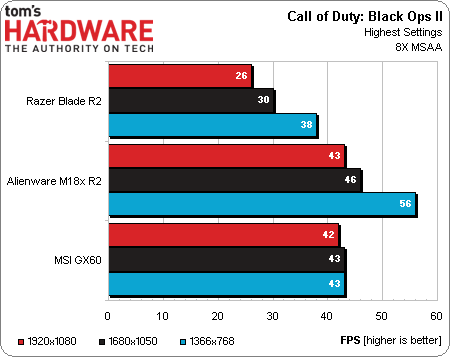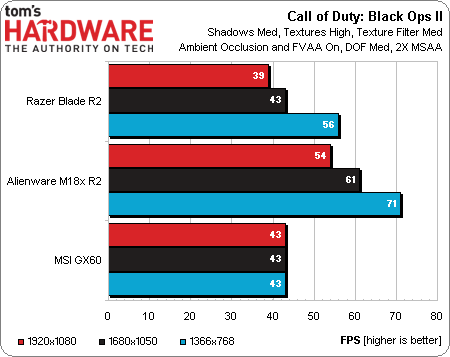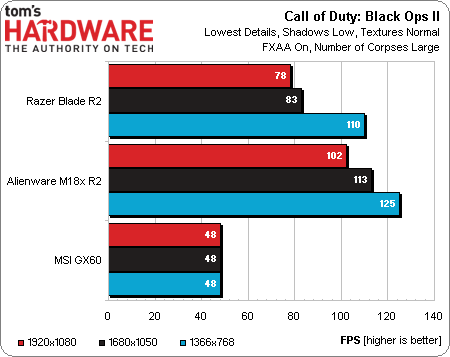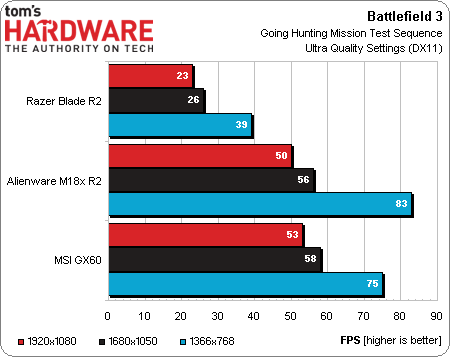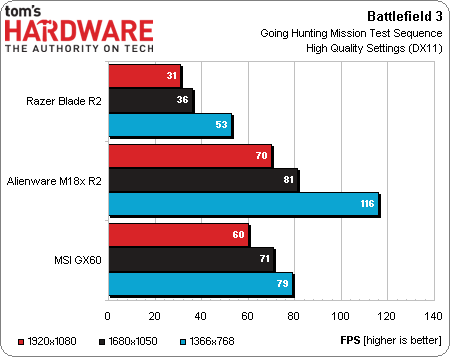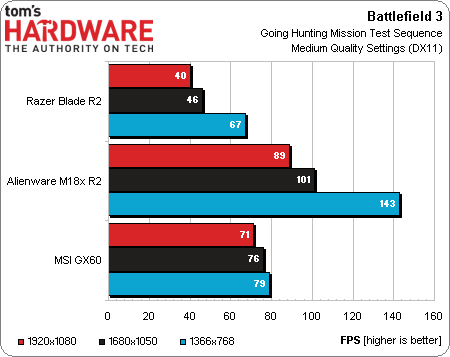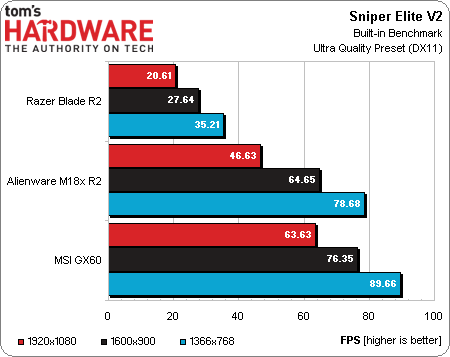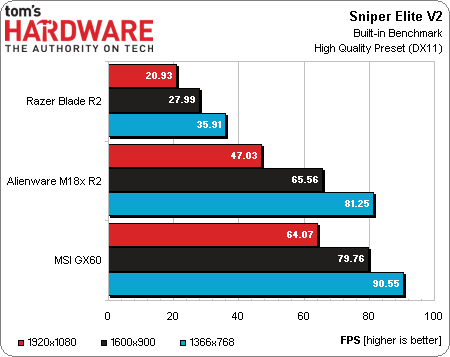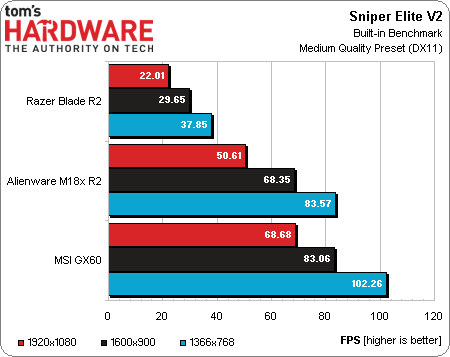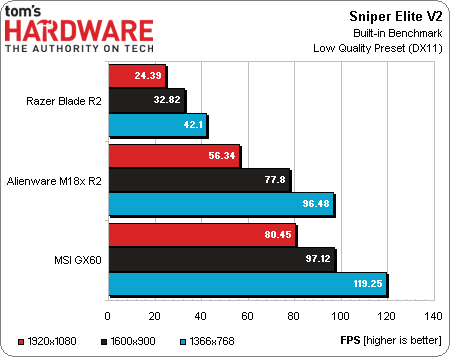Razer's Second-Generation Blade Notebook Review: Focusing On The Z
Razer recently sent us its second-gen Blade, complete with a Core i7-3632QM quad-core CPU and GeForce GTX 660M. Eight gigabytes of memory, a 500 GB hard drive, and an SSD cache round out this 17" gaming notebook. Would you believe it's less than 1" thick?
Black Ops II, Battlefield 3, Sniper Elite V2
Gaming tests were performed on the Razer Blade R2, an MSI GX60, and Alienware M18x. The GX60 uses AMD’s Radeon HD 7970M mobile GPU, while the M18x employs an Nvidia GeForce GTX 680M. The 7970M and GTX 680M represent the fastest mobile graphics modules currently available. Both comparison machines have 8 GB or RAM, and their CPUs and GPUs ran at factor clock rates.
A Note on FPS
We realize that acceptable frame rates are debatable on a per-game and per-vendor basis, which is why we're simply listing averages. As long as we're getting smooth game play, we typically choose higher-quality visuals over higher frame rates. After all, we want to see all of the work that game designers put into making a game visually appealing. Typically, I find that 20 FPS is the absolute minimum I'm willing to call acceptable, with 30 FPS a more ideal minimum. In multi-player games I favor higher frame rates and low lag.
Call of Duty: Black Ops II
Benchmark settings for Call of Duty: Black Ops II are the same as those in Call Of Duty: Black Ops II Graphics Performance, Benchmarked.
Starting off with the highest-quality settings, the Blade's GeForce GTX 660M does well at 1366x768 and 1680x1050, though 1920x1080 dips a bit lower than we'd like. Fortunately, we didn't have trouble actually playing through Call of Duty at any of these settings.
At Medium settings, frame rates are naturally faster on all of the notebooks, given us an even smoother experience on the Blade's GeForce GTX 660M.
Get Tom's Hardware's best news and in-depth reviews, straight to your inbox.
At the lowest detail settings, none of the machines have any trouble with even minimum frame rates. We're including these numbers mainly as a means to compare Razer's notebook to machines with slower GPUs.
Battlefield 3
Benchmark settings for Battlefield 3 are the same as those in Battlefield 3 Performance: 30+ Graphics Cards, Benchmarked.
The performance you get from a high-end GPU is evident in the chart above. The GeForce GTX 660M is certainly fast enough at 1366x768, and although I didn't have any trouble playing at the two higher resolutions, many folks will consider 26 and 23 average frames per second too low for a fast-paced first-person shooter. I did bump the settings down a notch for multiplayer, since that tends to be more processor-bound. But I still think the game would have been playable using the Ultra quality preset.
Dropping the settings down to High, the Blade R2 averages more than 30 FPS at 1920x1080, which we're far more comfortable with.
The Medium quality preset gives us another frame rate increase that makes the game more playable.
Sniper Elite V2
Sniper Elite V2 usually favors AMD's video cards. The built-in benchmark taxes graphics pretty heavily, while placing very little load on the CPU.
At Ultra settings, the Razer R2 only manages to achieve an average of 20 FPS at 1920x1080. However, the built-in benchmark appears to be much more demanding than the game itself. So, real game play is smoother than these results would otherwise suggest.
Dropping the in-game preset to High doesn't have much of an impact on any of these cards.
Graphics quality is still pretty good at the Medium quality preset. This benchmark still appears to be much harder on Nvidia's card than the Radeon HD 7970M.
The Low preset bumps average frame rates up by another 10%.
Current page: Black Ops II, Battlefield 3, Sniper Elite V2
Prev Page Productivity Benchmarks Next Page Hitman: Absolution, DiRT, And Arkham City-
ShadyHamster Having all the I/O on the left isn't such a bad idea, keeps the right side clear so cables don't get in the way if you use a mouse close to your laptop like i do.Reply -
mayankleoboy1 Wow, this is a very thorough review! Great work!Reply
This notebook has looked into almost every possible detail. I was particularly impressed that in the heat run, the "WASD" key area was cooler than the rest. This bespeaks extreme attention to details. -
Chairman Ray This is an amazing system. Great job by Razer! I won't be buying it due to the steep price tag, but definitely going to recommend it to those who are willing to pay for the best.Reply -
xpeh While the price is steep, this laptop is definitely one of the best looking gaming laptops I've ever seen.Reply -
g-unit1111 I very badly need to get a new laptop but this one is way too rich for my blood. I would definitely consider this if it were about $1K less.Reply -
Pyree g-unit1111I very badly need to get a new laptop but this one is way too rich for my blood. I would definitely consider this if it were about $1K less.Lenovo Y580/Y500 GT650m SLIReply -
slomo4sho xpehWhile the price is steep, this laptop is definitely one of the best looking gaming laptops I've ever seen.IMO having a $1000 gaming desktop and spending $500-600 on a laptop when Haswell comes out is probably much more economical for the occasional gaming on a laptop paired with a sold desktop to enjoy the higher quality graphics. Even at $2500, this laptop can't even keep up with the $500 budget gaming build from last month.Reply -
de5_Roy nice review. :)Reply
my real amusement came from the apu-powered laptop's performance, though. it bottlenecked the discreet gpu so badly.... :D -
corvak Gaming laptops have never been priced in a range that makes them worth buying for me. They don't really have enough battery life to really take advantage of portability, and the price/performance is in a whole other league if you compare it to any desktop build.Reply
Even buying a cheap laptop for travel use alongside a gaming desktop is likely to come in cheaper than many of these.
-
Goose_Nipples ARMY'S KA-Bar?!?!?!?! Hooooooold up my friend. Devil dog here who's jimmies have most assuredly been rustled.Reply
